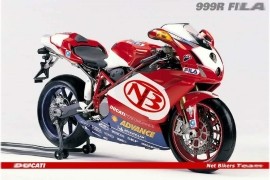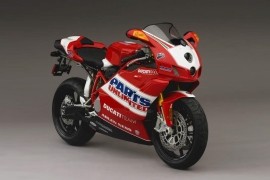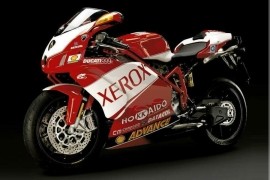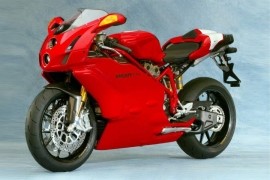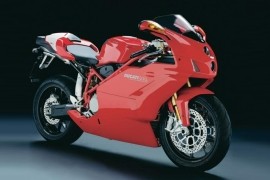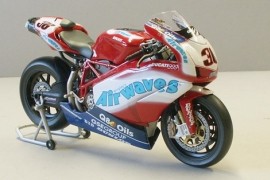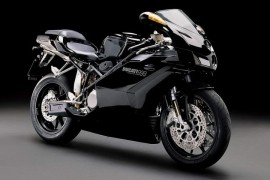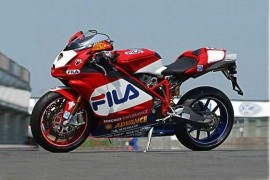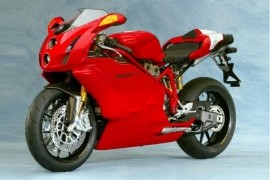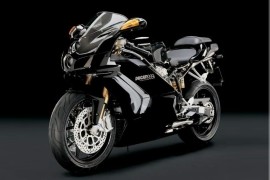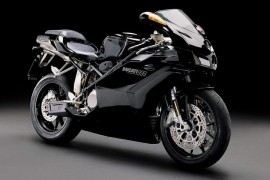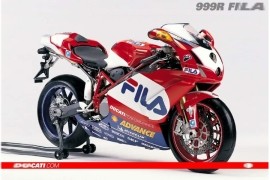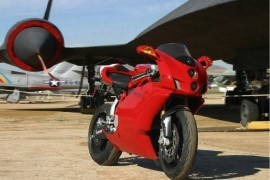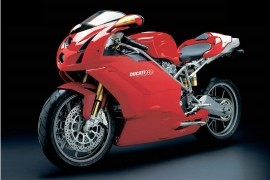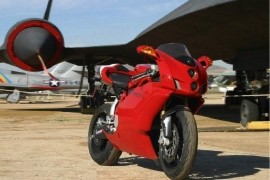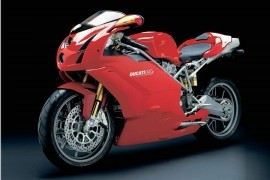DUCATI 999 Models/Series Timeline, Specifications & Photos
First production year: 2003
The 999 family of sports machines was created in 2003 when the Italian motorcycle manufacturer introduced the Ducati 999 as the first member of the range. In addition to the base model, the maker released the Ducati 999S and 999R, two more advanced and powerful models with race-derived suspension, brakes, and carbon fiber elements.
The 999 had great success right from the start of its journey through the sports bike world, winning the Superbike World Championship in 2003 with the 999 ridden by Neil Hodgson, in 2004 by James Toseland, and in 2006 with Troy Bayliss behind bars.
In 2007, the Italian motorcycle manufacturer released the Ducati 999R Net Bikers Team, a special edition machine with minor improvements in various departments. The bike was dressed in the same livery found on the official motorcycle that competed in the World Superbike Championship.
Some notable improvements received by the machine included carbon fiber side and upper fairings, a braced swingarm, magnesium head covers and headlight support, an Ohlins steering damper, and forged aluminum wheels.
In the performance department, the 2007 Ducati 999R Net Bikers Team had its muscles from a 999cc four-stroke liquid-cooled V-twin engine fed by an electronically controlled fuel injection system, boasting 146 hp at 9,750 rpm and 117 Nm (86 lb-ft) torque at 8,000 rpm.
The bike's six-speed manual transmission sent the engine power to the rear wheel through a final chain drive, pushing the motorcycle to 280 kph (174 mph).
In 2007, the Italian motorcycle maker launched the Ducati 999S Team USA Limited Edition, a road-legal version of the machine rode by Neil Hodgson and Ben Bostrom of the Ducati Parts Unlimited Team, made just for the American market in only 150 units.
The bike had the same mechanical parts and performance as the base Ducati 999S model but was wrapped in a unique graphic scheme that set it apart from any other 999 models. The bikes were made in Italy and shipped in the USA without the tail section, which was shipped separately in California for an autograph session.
In the appearance department, the special edition machine featured the same standard features as the base 999S model, including a full fairing, a single seat, an under-seat-mounted exhaust system, and Y-shaped five-spoke alloy wheels.
The bike's handling was achieved by a 43 mm fully adjustable USD TiN-coated Ohlins fork on the front and a fully adjustable Ohlins shock absorber with progressive linkage on the rear, delivering excellent handling capabilities.
The 2007 Ducati 999S Team USA Limited Edition took its muscles from a 999cc four-stroke V-twin liquid-cooled engine, boasting 143 hp at 9,750 rpm and 113 Nm (83 lb-ft) torque at 8,000 rpm.
The bike was set in motion by a six-speed manual transmission with a hydraulically controlled dry multi-plate clutch and a final chain drive, pushing the machine to 272 kph (169 mph).
In 2006, the Italian motorcycle manufacturer released the Ducati 999R Xerox Replica, a sports machine packed with many features that differentiated it from the base Ducati 999R model.
The Replica model featured an Ohlins fork on the front with black sleeves, anodized black footpegs, and top yoke, an Ohlins rear suspension shock with a double damping adjuster, an aluminum body, radial-mounted calipers with a red Brembo logo, Xerox Replica graphics, and a racing kit with extra adhesives.
In addition, the bike was also fitted with titanium valve collets, 12-hole racing fuel injectors, magnesium head covers, carbon fiber timing bet covers, and a carbon fiber silencer cover. The bike was designed to be as light as possible and deliver high performance without compromising reliability.
In the appearance department, the bike was identical to the base 999R model, with a full fairing, a small windscreen, a single seat, an under-seat-mounted exhaust system, and Y-shaped five-spoke alloy wheels.
As for power, the 2006 Ducati 999R Xerox Replica was handled by a 999cc four-stroke liquid-cooled V-twin engine fed by an electronically controlled fuel injection system, boasting 146 hp at 9,750 rpm and 117 Nm (86 lb-ft) torque at 8,000 rpm.
The engine power was transferred to a six-speed manual transmission with a hydraulically-controlled dry multi-plate clutch and a final chain drive, pushing the machine to a top speed of 280 kph (174 mph).
In 2006, the Italian motorcycle manufacturer released the Ducati 999R, a sports machine that debuted in 2003 alongside the standard 999 and 999S. The bikes were known on the streets as the Triple Nine or Nine-nine-nine and were designed by Pierre Terblanche.
Compared to the base model, the Ducati 999R was more powerful and featured race-derived suspensions, brakes, and several carbon fiber bits and pieces. Of the three models, the 999R version was the most powerful.
In the appearance department, the 2006 Ducati 999R was fitted with standard features, such as carbon fiber bodywork, a small windscreen, a single seat, an exhaust system mounted under the seat, and Y-shaped five-spoke alloy wheels.
The bike's race-derived suspension comprised a 43 mm fully adjustable USD TiN-coated Ohlins fork on the front end. In contrast, the rear end was operated by a fully adjustable Ohlins Shock absorber with progressive linkage.
The stopping power came from two 320 mm discs with four-piston calipers on the front wheel and a 245 mm disc with a dual-piston caliper on the rear wheel.
As for the power figures, the 2006 Ducati 999R had its soul brought to life by a 999cc four-stroke liquid-cooled V-twin engine with a fuel injection system feeding the pistons, delivering 146 hp at 9,750 rpm and 117 Nm (86 lb-ft) torque at 8,000 rpm.
The Ducati 999 was a sports machine made from 2003 to 2006, also known as the Triple Nine or Nine-nine-nine. The bike was designed by Pierre Terblanche and replaced the Ducati 916, 996, and 998 superbikes designed by Massimo Tamburini.
In addition to the standard 999 model, the Italian manufacturer made the Ducati 999S and 999R available. Both machines packed more advanced suspensions and brakes than the base model but also more power.
In 2006, the Italian motorcycle manufacturer launched the Ducati 999S, a sports motorcycle that debuted in 2003. The bike didn't feature any significant modifications compared to the previous model and delivered the same specifications.
In the aesthetic department, the bike packed standard features, such as a full fairing, a small windscreen, a single seat, an under-seat-mounted exhaust system, a side stand, and lightweight 10-spoke lightweight alloy wheels.
As for power, the 2006 Ducati 999S took its muscles from a 999cc four-stroke liquid-cooled V-twin engine with an electronically controlled fuel injection system in charge, delivering an output power of 143 hp at 9,750 rpm and 113 Nm (83 lb-ft) torque at 8,000 rpm.
Compared to the standard model, the 999S comprised a race-derived suspension system, including a 43 mm fully adjustable upside-down TiN-coated Ohlins fork on the front and a fully adjustable Ohlins shock absorber on the rear, providing excellent suspension performance and handling.
The Ducati 999 was a sports machine manufactured from 2003 to 2006, also known as the Triple Nine or Nine-nine-nine on the streets. The bike was designed by Pierre Terblanche and replaced the Ducati 916, 996, and 998 superbikes designed by Massimo Tamburini.
In 2006, the Italian motorcycle manufacturer launched the Ducati 999 Airwaves Replica, a limited-edition motorcycle based on the 999 and 749 models. The bike was limited to 30 units worldwide and was dressed in the same graphics scheme as the bike ridden by Gregorio Lavilla and Leon Haslam in official races.
The special edition machine featured a tuned engine for more power and torque but also in the suspension department for more responsive handling from its Showa suspension package.
The bike was fitted with a 43 mm upside-down Showa telescopic fork on the front end. In contrast, the rear end was operated by a fully adjustable Showa shock absorber with progressive linkage.
In the safety department, the bike packed two 320 mm discs with four-piston calipers on the front wheel and a 245 mm disc with a dual-piston caliper on the rear wheel, delivering excellent stopping power.
The 2006 Ducati 999 Airwaves Replica was brought to life by a 999cc liquid-cooled V-twin fuel-injected engine that delivered an output power of 150 hp at 9,750 rpm and 102 Nm (75 lb-ft) torque at 8,000 rpm, pushing the bike to 260 kph (162 mph).
It all started back in 2003 when the Italian motorcycle manufacturer launched the Ducati 999. The 999 sports motorcycle was designed by Pierre Terblanche, replacing the Ducati 916, 996, and 998 superbikes designed by Massimo Tamburini.
Right from the beginning, the Ducati 999 enjoyed great success in the Superbike World Championship by winning the race in 2003, 2004, and 2006. In 2003, Ducati won with Neil Hodgson at controls, in 2004 with James Toseland on the saddle, and in 2006 with Troy Bayliss riding the machine.
The Ducati 999 didn't come alone but was joined by the Ducati 999S and 999R, two models with different characteristics and performances. The most powerful was the Ducati 999R, with race-derived suspensions, top-end Brembo brakes, a remapped engine that delivered more power and torque, and several carbon fiber parts.
In 2006, the Italian motorcycle manufacturer launched the Ducatii 999, a sports machine in its final year of production, similar to previous models. Compared to the first model, the bike delivered more output power and featured several visual improvements.
In the appearance department, the bike was fitted with standard features, such as a full fairing, a small windscreen, vertically stacked headlights, a two-piece dual seat, an under-seat-mounted exhaust system, and 10-spoke lightweight alloy wheels.
As for the power figures, the 2006 Ducati 999 had its heartbeat set by a 999cc liquid-cooled V-twin fuel-injected engine that delivered an output power of 140 hp at 9,750 rpm and 102 Nm (75 lb-ft) torque at 8,000 rpm.
The Ducati 999 was a sports motorcycle manufactured by Ducati from 2003 to 2006. The bike replaced the Ducati 916, 996, and 998 superbikes designed by Massimo Tamburini. The bike was also known as the Triple Nine or Nine-nine-nine on the streets.
Right from the beginning, the Ducati 999 had great success in the Superbike World Championship, winning in 2003 with Neil Hodgson behind bars, in 2004 with James Toseland at controls, and in 2006 with Troy Bayliss riding.
In 2005, the Italian motorcycle manufacturer launched the Ducati 999R Fila Toseland Replica, a machine built in honor of James Toseland that won the 2004 Superbike World Championship. The 2005 Ducati 999R Fila Toseland Replica was an exquisitely crafted machine with the lightest materials and delicate parts found anywhere in the world.
The bike was based on the 2004 Ducati 999R and featured full Fila/Ducati Corse WSBK graphics, carbon fiber side, upper fairings, a WSBK-inspired swingarm, magnesium head covers, headlight support, and forged aluminum wheels. At the time, the bike was available at an MSRP of $24,995.
As for power, the 2005 Ducati 999R Fila Toseland Replica had its muscles from a 999cc four-stroke liquid-cooled V-twin fuel-injected engine that delivered an output power of 146 hp at 9,750 rpm and 117 Nm (86 lb-ft) torque at 8,000 rpm.
The bike's power was delivered to the ground through a six-speed manual transmission with a hydraulically-operated dry multi-plate clutch and a final chain drive, pushing the machine to 280 kph (174 mph).
In 2003, the Italian motorcycle manufacturer launched the Ducati 999, a sports bike designed by Pierre Terblanche that replaced the Ducati 916, 996, and 998 superbikes developed by Massimo Tamburini.
Alongside the standard Ducati 999, the maker released the 999S and 999R models, which were slightly more powerful and equipped with race-derived suspension and braking systems.
In 2005, the Italian motorcycle manufacturer launched the Ducati 999R, a machine in its third year of production that came without any significant modifications compared to previous models.
In the appearance departments, the bike packed standard features, such as a full fairing, a small windscreen, a single seat, an under-seat-mounted exhaust system, a tubular steel Trellis frame, and 10-spoke lightweight alloy wheels.
The bike's suspension system comprised a 43 mm fully adjustable upside-down TiN-coated Ohlins fork on the front and a fully adjustable Ohlins shock absorber on the rear, delivering excellent suspension performance and handling.
The braking power was achieved by two 320 mm discs coupled to four-piston calipers on the front wheel and a 245 mm disc with a dual-piston caliper on the rear wheel, offering strong and reliable stopping power.
As for the power figures, the 2005 Ducati 999R had its soul brought to life by a 999cc four-stroke V-twin liquid-cooled fuel-injected engine that delivered 146 hp with a peak force at 9,750 rpm and 117 Nm (86 lb-ft) torque at 8,000 rpm.
In 2005, the Italian motorcycle maker released the Ducati 999S, a sports machine part of the 999 family in Ducati's range. The bike debuted in 2003 and was designed by Pierre Terblanche, replacing the Ducati 916, 996, and 998 superbikes.
Compared to the standard Ducati 999 model, the 999S version was slightly more advanced, featuring a race-derived Ohlins suspension system, a Brembo braking System, and a tuned engine that delivered somewhat more power.
As for the appearance, the bike was identical to the base model, packing the same full fairing with a small windscreen, two small round headlights, a two-piece dual seat, an exhaust system mounted under the seat, a digital instrument panel, and 10-spoke lightweight alloy wheels.
The tubular steel Trellis frame was coupled to a 43 mm fully adjustable upside-down TiN-coated Ohlins fork on the front and a fully adjustable Ohlins shock absorber with progressive linkage on the rear.
The braking system remained unchanged, with two 320 mm discs, four-piston calipers on the front, and a 245 mm disc with a dual-piston caliper on the rear, delivering excellent stopping power.
As for the power figures, the 2005 Ducati 999S had its heartbeat set by a 999cc four-stroke V-twin liquid-cooled engine fed by an electronically controlled fuel injection system, delivering 143 hp at 9,750 rpm and 113 Nm (83 lb-ft) torque at 8,000 rpm.
In 2005, the Italian motorcycle manufacturer launched the Ducati 999, a sports machine that debuted in 2003 alongside the Ducati 999S and Ducati 99R. The 999 model was designed by Pierre Terblanche and was known as the Triple Nine or Nine-nine-nine on the streets.
The bike had great success in the World Superbike Championship, winning in 2003 with Neil Hodgson behind bars, in 2004 ridden by James Toseland, and in 2006 with Troy Bayliss at controls.
The 2005 Ducati 999 packed standard features, such as a full fairing with a small windscreen, dual vertically stacked small round headlights, a two-piece double seat, an under-seat-mounted exhaust system, and 10-spoke lightweight alloy wheels.
The bike's suspension remained unchanged, comprising a 43 mm upside-down Showa fork on the front and a fully adjustable Showa shock absorber with progressive linkage on the rear.
As for the braking power, the bike packed two 320 mm discs with four-piston calipers on the front wheel and a 245 mm disc with a two-piston caliper on the rear wheel, offering optimal stopping power.
The 2005 Ducati 999 took its muscles from a 999cc four-stroke liquid-cooled V-twin engine that delivered an output power of 140 hp with a peak at 9,750 rpm and 102 Nm (75 lb-ft) torque with maximum strength at 8,000 rpm.
The Ducati 999 was a sport motorcycle manufactured from 2003 to 2006, replacing the Ducati 916, 996, and 998 designed by Massimo Tamburini. The Ducati 999 model was designed by Pierre Terblanche and was also known on the streets as the Triple Nine or Nine-nine-nine.
In addition to the standard model, the Italian motorcycle manufacturer made the Ducati 999S and 999R available. Compared to the base model, the 999S model packed a race-derived suspension system, Brembo brakes, and a remapped engine.
Also, the Ducati 999R was a little more special than the base and S models, packing the same racing suspension as the S model, the same brakes, and an engine squeezed to the extreme to deliver the maximum power possible, along with several carbon fiber parts for less weight.
In 2004, the Italian motorcycle manufacturer launched the Ducati 999R Fila 200th Win Limited Edition. The bike was created to celebrate Ducati's 200th win in the World Superbike Championship, achieved by Neil Hodgson on May 18, 2003.
The bike was dressed in a livery virtually identical to the official one used on the race bike and was limited to only 200 units. Also, the machine featured an improved power output, more than the 999R.
Other notable features included carbon fiber side and upper fairings, magnesium head covers, headlight support, forged aluminum wheels, and a WSBK-inspired braced Swingarm.
As for the power figures, the 2004 Ducati 999R Fila 200th Win Limited Edition packed a 999cc fur-stroke liquid-cooled engine with 146 hp available at 10,000 rpm and 108 Nm (80 lb-ft) torque at 8,000 rpm.
In 2004, the Italian motorcycle manufacturer launched the Ducati 999R, a sports bike that debuted in 2003, designed by Pierre Terblanche. The bike was also known as the Triple Nine or Nine-nine-nine.
Compared to the standard model, the Ducati 999R featured a race-derived suspension system, Brembo brakes, a tuned engine from which the Italian engineers squeezed as much output as possible, and several carbon fiber parts that reduced the overall weight.
Also, the 999R was delivered to customers with a complete kit designed only for track use. The kit comprised a Termignoni 102 Db exhaust system with a rear-half manifold without a catalytic converter and a dedicated Electronic Control Unit (ECU) that reduced weight and improved performance.
In the aesthetic department, the Ducati 999R was similar to its siblings, wearing the same full fairing with a small windscreen, vertically stacked small round headlights, a single seat, an under-seat-mounted exhaust system, and 10-spoke forged alloy wheels.
The bike's suspension comprised a 43 mm fully adjustable upside-down TiN-coated Ohlins fork on the front with 120 mm wheel travel and a fully adjustable Ohlins shock absorber with 128 mm wheel travel on the rear.
As for the power figures, the 2004 Ducati 999R had its soul brought to life by a 999cc four-stroke liquid-cooled engine with a fuel injection system in charge, delivering an output power of 139 hp at 10,000 rpm and 108 Nm (80 lb-ft) torque at 8,000 rpm.
In 2004, alongside the Ducati 999 standard and 999R models, the Italian motorcycle manufacturer launched the Ducati 999S, a sports machine that debuted in 2003, designed by Pierre Terblanche and known on the streets as the Triple Nine or Nine-nine-nine.
Compared to the standard model, the Ducati 999S was fitted with a race-derived Ohlins suspension system, Brembo brakes, and a remapped engine with more power and torque available for the rider.
In the visual department, the bike remained unchanged, packing the same full fairing with a small windscreen, small vertically-stacked round headlights, a single seat, an under-seat-mounted exhaust system that offered great lean angles, and 10-spoke lightweight alloy wheels.
The bike's handling was achieved by a 43 mm fully adjustable upside-down TiN-coated Ohlins fork with 120 mm wheel travel on the front and a fully adjustable Ohlins shock absorber with 128 mm wheel travel on the rear.
In the braking department, the bike packed two 320 mm discs with four-piston calipers on the front wheel and a 245 mm disc with a dual-piston caliper on the rear wheel, delivering excellent stopping power.
As for the power figures, the 2004 Ducati 999S had its soul brought to life by a 999cc four-stroke liquid-cooled V-twin engine that delivered an output power of 136 hp with a peak force at 9,750 rpm and 106 Nm (78 lb-ft) torque at 8,000 rpm.
In 2004, the Italian motorcycle manufacturer launched the Ducati 999, a sports bike in its second year of production that came in the same package as the previous model, without any performance, visual, or technical modifications.
The 999 model was a sports machine manufactured from 2003 to 2006 that replaced the Ducati 916, 996, and 998 models. The bike was designed by Pierre Terblanche and was known as a high-performance and race-oriented machine. In addition, the bike was known on the streets as the Triple Nine or Nine-nine-nine.
It also had great success in the Superbike World Championship, being raced until 2007, although the production stopped in 2006. In 2003, the bike won with Neil Hodgson on the saddle, in 2004 with James Toseland behind bars, and in 2006 ridden by Troy Bayliss.
The 2004 Ducati 999 featured a full fairing with a small windscreen, two small, round, vertically stacked headlights, a single seat with a passenger cover, an under-seat-mounted exhaust system, and lightweight 10-spoke alloy wheels.
Compared to the 999s and 999R, the Ducati 999 featured a standard suspension system comprised of a 43 mm upside-down Showa fork on the front and a fully adjustable Showa shock absorber with progressive linkage on the rear.
The Ducati 999 was the less powerful machine between the 999S and 999R, packing a 999cc four-stroke liquid-cooled V-twin engine that delivered an output power of 124 hp with a peak at 9,500 rpm and 102 Nm (75 lb-ft) torque at 8,000 rpm.
The Ducati 999 was a sports bike manufactured from 2003 to 2006 that replaced the Ducati 916, 996, and 998 superbikes designed by Massimo Tamburini. The 999 model was designed by Pierre Terblanche and was known on the streets as the Triple Nine or Nine-nine-nine.
The 999 featured great success in the Superbike World Championship, coming in first place in 2003 with Neil Hodgson behind bars, in 2004 with James Toseland on the seat, and in 2006 ridden by Troy Bayliss. It also raced in the series through 2007, despite its production ended in 2006.
Alongside the standard model, the Italian motorcycle manufacturer launched the Ducati 999R, a sports bike with a remapped engine that squeezed the highest possible power output and a bodywork that featured several carbon fiber elements for a lower weight.
In other departments, the 999R was similar to its siblings, packing the same full fairing with a small windscreen, two small, round, vertically stacked headlights, a single seat, an under-seat-mounted exhaust system, and 10-spoke lightweight alloy wheels.
The 2003 Ducati 999R had its heartbeat set by a tuned 999cc four-stroke liquid-cooled V-twin engine that delivered 139 hp with maximum strength at 10,000 rpm and 108 Nm (80 lb-ft) torque at 8,000 rpm.
To put the power down to the ground, the 2003 Ducati 999R was fitted with a six-speed manual transmission, a hydraulically-operated dry multi-plate clutch, and a final chain drive, pushing the machine to 280 kph (174 mph).
In 2003, the Italian motorcycle manufacturer released the Ducati 999 alongside two more powerful machines, Ducati 999S, and Ducati 999R. The 999 model was designed by Pierre Terblanche and was also known as Nine-nine-nine or Triple Nine.
From the beginning, the Ducati 999 had great success in the Superbike World Championship, winning in 2003 with Neil Hodgson behind bars, in 2004 ridden by James Toseland, and in 2006 by Troy Bayliss.
In 2003, alongside the standard model, the maker released the Ducati 999S, a sports bike with superior maneuverability and safety due to its Ohlins suspension system, Brembo braking power, and remapped engine with more power and torque.
In the visual department, the 999S model was identical to the base model, packing the same full fairing with two small, round headlights, a small windscreen, a single seat, an exhaust system mounted under the seat, and ten-spoke lightweight alloy wheels.
Compared to the base model, the 999S was handled by a fully adjustable upside-down TiN-coated Ohlins fork on the front and a fully adjustable Ohlins shock absorber with progressive linkage on the rear.
The braking power was achieved by Brembo components, such as two 320 mm discs with four-piston calipers on the front wheel and a 245 mm disc with a dual-piston caliper on the rear wheel.
As for power, the 2003 Ducati 999S had its muscles from a 999cc four-stroke liquid-cooled V-twin engine, boasting 136 hp with a peak at 9,750 rpm and 106 Nm (78 lb-ft) torque at 8,000 rpm.
The Ducati 999 was a sports bike produced by Ducati for only four years, from 2003 to 2006, and replaced the Ducati 916, 996, and 998 superbikes designed by Massimo Tamburini. The Ducati 999 was designed by Pierre Terblanche and was known as a high-performance, race-oriented machine.
The bike had at its core a Ducati L-twin Desmodromic Valve actuated engine with linear power delivery, high power, and torque even at lower engine speeds, and a high-spec trellis frame and suspension, which made it one of the finest handling machines at the time.
The Ducati 999 had great success in World Superbike, being raced through 2007, although the production was stopped in 2006. In addition, Ducati introduced two other more powerful machines in the form of 999S and 999R models, with outstanding performance and high-speed figures.
In the visual department, the 2004 Ducati 999 packed standard features, such as a full, clean fairing, a small windscreen, two small, round stacked headlights, a single seat with a passenger cover, an under-seat-mounted exhaust system, and five Y-shaped spoke alloy wheels.
The power generator of the 2004 Ducati 999 was a 999cc four-stroke V-twin liquid-cooled engine fed by an electronically controlled fuel injection system, delivering an output power of 124 hp at 9,500 rpm and 102 Nm (75 lb-ft) torque at 8,000 rpm.
The bike's power was handled by a six-speed manual transmission with a hydraulically controlled dry multi-plate clutch and a final chain drive, sending the machine to a top speed of 266 kph (166 mph).
